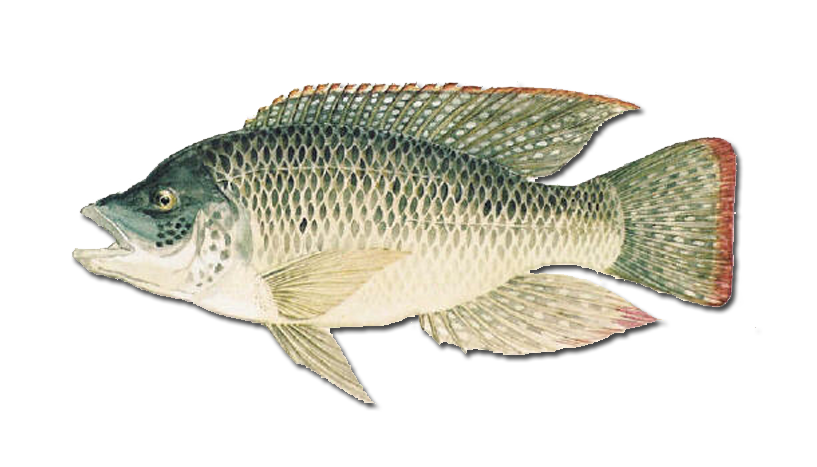
Mozambique Tilapia (Oreochromis mossambicus) is native to Malawi, Mozambique, Swaziland, Zambia, Zimbabwe and South Africa. In South Africa, its range is limited to the Eastern Cape Province and KwaZulu-Natal. The fish lives in the Lower Zambezi River and the Lower Shire River as well as on the coastal plains from the Zambezi delta to Algoa Bay. The geographical range of the species proceeds southwards to Bushmans River in the Eastern Cape Province and the fish is also found in Transvaal in the Limpopo system. In addition to this, the Mozambique Tilapia is widely dispersed beyond this range to inland regions and to the south west and west coastal rivers including the lower Orange River and rivers of Namibia.
The Mozambique Tilapia has been introduced by man to many different tropical and subtropical parts of the world, as well as to some warm temperate regions.
The Mozambique Tilapia is found in many different waters, with the exception of fast-flowing rivers and streams. It is known to appreciate standing water. The Mozambique Tilapia is considered a freshwater species but it can be found in both estuaries and coastal lakes, especially in the southern part of its geographical range.
The Mozambique Tilapia Appearance
Oreochromis mossambicus is a laterally compressed fish with a deep body. The dorsal fin is long and the front part of it is equipped with protective spines. The main body coloration is yellow, but the exact coloration varies a lot from fish to fish.
The Mozambique Tilapia Feeding

The Mozambique tilapia is a filter feeder that filters plankton out of the water. The fish is capable of secreting mucous that traps the plankton. The plankton will then be grinded between two pharyngeal plates. When the grinded planktons reach the stomach of the fish, their cells will burst since the environment is highly acidic with a pH-value around 2. Planktons are however not the only things on the menu for the versatile Mozambique tilapia; this omnivore will happily gulp down detritus (decomposing organic matter), plants, insects, aquatic invertebrates and fry as well. In the plant kingdom, it is known to eat pretty much anything from diatoms to macroalgae, as well as rooted plants. The Mozambique tilapia will adapt its diet to the environment and the exact diet of this species will therefore vary a lot from location to location.
The Mozambique Tilapia Reproduction
Breeding Mozambique tilapia in the aquarium is not difficult and the fish can start breeding when it is roughly 8-9 months of age. It can however be hard to distinguish the males from the females since they look very similar. One of the easiest ways of obtaining a pair is to let at least 5-6 fishes grow up together and form their own pairs.
Before any spawning takes place, the male will dig out a saucer-shaped nest on the sandy bottom. (It is therefore a good idea to use sand instead of coarse gravel in the aquarium if you want to breed Mozambique tilapia.) During spawning, the female will release her eggs into the nest.
Just like many other African cichlids, the Mozambique tilapia is a maternal mouthbrooder. In many African cichlid species the female will pick up the eggs before they are fertilized, but the Mozambique tilapia female waits until the male has fertilized the eggs in the nest. She will then pick them up and keep eggs, larvae and small fry protected inside her mouth until the fry are large enough to be released. The eggs will normally hatch after 3-5 days, but it will then take at least 10-14 days before the fry is released.
Newly released Mozambique tilapia fry will shoal in shallow water in the wild, and they will try to stick to this behavior in the aquarium as well. You can feed the fry newly hatched brine shrimp as soon as they have been released.
During the breeding season, the pair will raise a new batch every 3-4 weeks. If you don’t have enough space to keep a myriad of Mozambique tilapia it is best to euthanize them at a young age or let them become food for predatory fish. If you allow your aquarium to become crowded it can lead to stunted Mozambique tilapias.
Mozambique Tilapia in Aquacultures
Oreochromis mossambicus is a popular fish among fish farmers since it is hardy and easy to grow. The fish is a popular food fish with white, mild flesh. It is however far from the most common tilapia species in aquacultures; roughly 4 percent of the total global tilapia aquaculture production is made up by Oreochromis mossambicus. Despite this, Oreochromis mossambicus is a very important species for the fish farming industry since it is used extensively for hybridization.
Mozambique Tilapia in Aquariums
Mozambique tilapia can be kept in aquariums but only if you have a big aquarium since it can exceed 40 cm (16 inches) in length as an adult. It grows really fast, so you will need that large aquarium fairly soon even if you purchase small juvenile specimens. The Mozambique tilapia is a hardy species, but it tends to be a messy eater and frequent water changes will therefore be required in order to keep the water quality up. The Mozambique tilapia is normally fairly peaceful as long at its young, but older specimens are known to become increasingly aggressive.
As mentioned above, the Mozambique tilapia is an omnivore species that will try most types of food. In the aquarium, they will eat virtually all kinds of prepared foods, including flakes, pellets and wafers. It is a good idea to supplement dry food with fresh vegetables such as zucchini and peas, and small servings of meaty live or frozen food, e.g. mosquito larvae and shrimps.
Conservation Status for Oreochromis Mossambicus
The Mozambique tilapia, Oreochromis mossambicus, is listed as Near Threatened (NT) on the IUCN Red List of Threatened Species. The Nile tilapia, Oreochromis niloticus, has entered the geographical range of Oreochromis mossambicus in the Zambezi and Limpopo systems with the help of anglers and fish farmers. This is a problem, since this two species readily mates with each other which leads to hybridization. According to IUCN, the Mozambique tilapia is likely to become locally extinct in those systems. Hybridization is not the only problem; competition can also pose a threat to the Mozambique tilapia.
Oreochromis Mossambicus as an Invasive Species
In some places, Oreochromis mossambicus have become an invasive species after being deliberately or accidentally introduced by man. It has for instance caused a sharp decline in the number of Striped mullets (Mugil cephalus) in Hawaii. The species is also suspected to be responsible for the problems experienced by the Desert pupfish (Cyprinodon macularius) in Salton Sea, California.
The Mozambique tilapia has been nominated by the IUCN Invasive Species Specialist Group (ISSG) as one of the species belonging to the group “100 of the World’s Worst Invasive Alien Species”.
The Mozambique tilapia is a highly adaptable species that can survive and even thrive in many different environments. This is naturally a good thing for the tilapia itself, but it is also what makes it such a risky introduction to non-native waters. It will for instance breed even in environments where food is scarce, and each female can rear several large broods each breeding season. The offspring can start breeding when they are no older than 8-9 months. The Mozambique tilapia is known to tolerate temperatures from 40 degrees F (4.4 degrees C) to 104 degrees F (40 degrees C), and they are also very tolerant when it comes to poor water quality, pollution and oxygen scarcity. They can survive in everything from lakes and major rivers to ditches to tiny ponds and can handle both fresh and brackish conditions. The Mozambique tilapia is also an opportunistic omnivore that will explore a wide range of different food source, from plankton and rooted plants to invertebrates and fish fry.




Leave a Reply